
Equestrianism, commonly known as horse riding or horseback riding, includes the disciplines of riding, driving, and vaulting. This broad description includes the use of horses for practical working purposes, transportation, recreational activities, artistic or cultural exercises, and competitive sport.

Rodeo is a competitive equestrian sport that arose out of the working practices of cattle herding in Spain and Mexico, expanding throughout the Americas and to other nations. It was originally based on the skills required of the working vaqueros and later, cowboys, in what today is the western United States, western Canada, and northern Mexico. Today, it is a sporting event that involves horses and other livestock, designed to test the skill and speed of the cowboys and cowgirls. American-style professional rodeos generally comprise the following events: tie-down roping, team roping, steer wrestling, Steer roping, saddle bronc riding, bareback bronc riding, bull riding and barrel racing. The events are divided into two basic categories: the rough stock events and the timed events. Depending on sanctioning organization and region, other events such as breakaway roping, goat tying, and pole bending may also be a part of some rodeos. The "world's first public cowboy contest" was held on July 4, 1883, in Pecos, Texas, between cattle driver Trav Windham and roper Morg Livingston.

A cowboy is an animal herder who tends cattle on ranches in North America, traditionally on horseback, and often performs a multitude of other ranch-related tasks. The historic American cowboy of the late 19th century arose from the vaquero traditions of northern Mexico and became a figure of special significance and legend. A subtype, called a wrangler, specifically tends the horses used to work cattle. In addition to ranch work, some cowboys work for or participate in rodeos. Cowgirls, first defined as such in the late 19th century, had a less-well documented historical role, but in the modern world work at identical tasks and have obtained considerable respect for their achievements. Cattle handlers in many other parts of the world, particularly South America and stockmen and jackaroos in Australia, perform work similar to the cowboy.
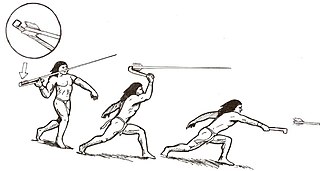
A spear-thrower, spear-throwing lever, or atlatl is a tool that uses leverage to achieve greater velocity in dart or javelin-throwing, and includes a bearing surface that allows the user to store energy during the throw.
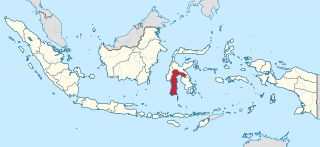
South Sulawesi is a province in the southern peninsula of Sulawesi, Indonesia. The Selayar Islands archipelago to the south of Sulawesi is also part of the province. The capital and largest city is Makassar. The province is bordered by Central Sulawesi and West Sulawesi to the north, the Gulf of Bone and Southeast Sulawesi to the east, Makassar Strait to the west, and Flores Sea to the south.
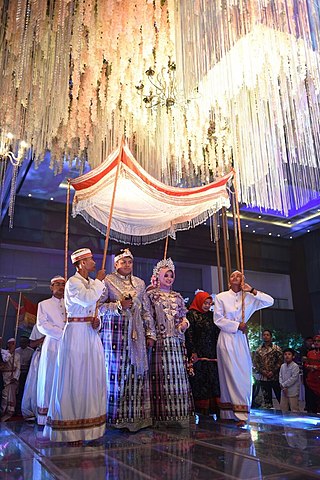
The Bugis people, also known as Buginese, are an Austronesian ethnic group—the most numerous of the three major linguistic and ethnic groups of South Sulawesi, in the south-western province of Sulawesi, third-largest island of Indonesia. The Bugis in 1605 converted to Islam from Animism. Although the majority of Bugis are Muslim, a small minority adhere to Christianity as well as a pre-Islamic indigenous belief called Tolotang.

A horse show is a judged exhibition of horses and ponies. Many different horse breeds and equestrian disciplines hold competitions worldwide, from local to the international levels. Most horse shows run from one to three days, sometimes longer for major, all-breed events or national and international championships in a given discipline or breed. Most shows consist of a series of different performances, called classes, wherein a group of horses with similar training or characteristics compete against one another for awards and, often, prize money.

The culture of Indonesia has been shaped by long interaction between original indigenous customs and multiple foreign influences. Indonesia is centrally-located along ancient trading routes between the Far East, South Asia and the Middle East, resulting in many cultural practices being strongly influenced by a multitude of religions, including Buddhism, Christianity, Confucianism, Hinduism, and Islam, all strong in the major trading cities. The result is a complex cultural mixture, often different from the original indigenous cultures.

Charrería is a sport and discipline arising from equestrian activities and livestock traditions used in the haciendas of old Mexico.

Hunt seat is a style of forward seat riding commonly found in North American horse shows. Along with dressage, it is one of the two classic forms of English riding. The hunt seat is based on the tradition of fox hunting. Hunt seat competition in North America includes both flat and over fences for show hunters, which judge the horse's movement and form, and equitation classes, which judge the rider's ability both on the flat and over fences. The term hunt seat may also refer to any form of forward seat riding, including the kind seen in show jumping and eventing.

Pencak silat is an umbrella term for a class of related Indonesian martial arts. In neighbouring countries, the term usually refers to professional competitive silat. It is a full-body fighting form incorporating strikes, grappling, and throwing, in addition to weaponry. Every part of the body is used and subject to attack. Pencak silat was practiced not only for physical defense but also for psychological ends. There are hundreds of different pencak silat styles and schools which tend to focus either on strikes, joint manipulation, weaponry, or some combination thereof.

Mentawai people are the native people of the Mentawai Islands about 100 miles from West Sumatra province, Indonesia. They live a semi-nomadic hunter-gatherer lifestyle in the coastal and rainforest environments of the islands and are also one of the oldest tribes in Indonesia. The Mentawai population is estimated to be about 64,000. The Mentawai tribe is documented to have migrated from Nias – a northern island – to the Mentawai islands, living in an isolated life for centuries until they encountered the Dutch in 1621. The ancestors of the indigenous Mentawai people are believed to have first migrated to the region somewhere between 2000 and 500 BCE. The Mentawai language belongs to the Austronesian language family. They follow their own animist belief system called Arat Sabulungan, that links the supernatural powers of ancestral spirits to the ecology of the rainforest. When the spirits are not treated well or forgotten, they might bring bad luck like illnesses and haunt those who forgot them. Mentawai also have very strong belief towards objects they think are holy. The people are characterized by their heavy spirituality, body art and their tendency to sharpen their teeth, a cultural practice tied to Mentawai beauty ideals. Mentawai tend to live in unison and peace with the nature around them because they believe that all things in nature have a form of spiritual essence.

Animals in sport are a specific form of working animals. Many animals, at least in more commercial sports, are highly trained. Two of the most common animals in sport are horses and dogs.
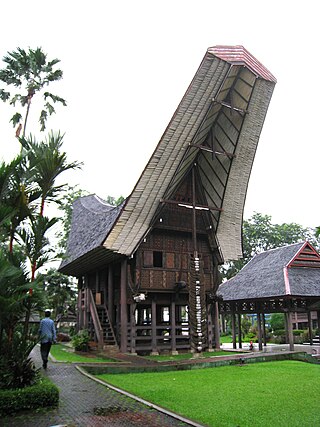
Tongkonan is the traditional ancestral house, or rumah adat of the Torajan people, in South Sulawesi, Indonesia. Tongkonan has a distinguishing boat-shaped and oversized saddleback roof. Like most of the Indonesia's Austronesian-based traditional architectures, tongkonan are built on piles. The construction of tongkonan is a laborious work and it is usually built with the help of all family members or friends. In the original Toraja society, only nobles had the right to build tongkonan. Commoners live in smaller and less decorated homes called banua.

The Golden Eagle Festival, or simply Eagle Festival, is an annual neo-traditional
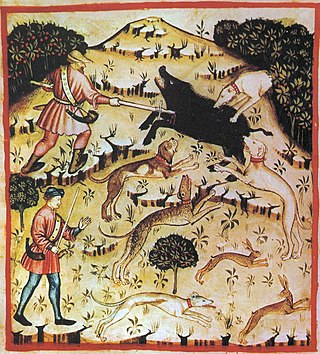
Boar hunting is the practice of hunting wild boar, feral pigs, warthogs, and peccaries. Boar hunting was historically a dangerous exercise due to the tusked animal's ambush tactics as well as its thick hide and dense bones rendering them difficult to kill with premodern weapons.
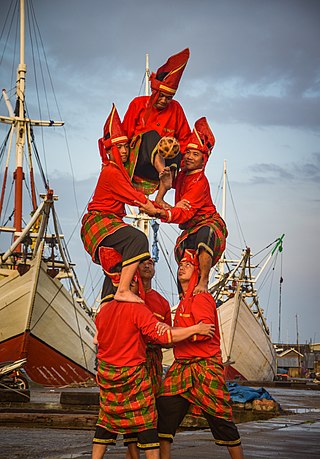
The Makassar or Makassarese people are an ethnic group that inhabits the southern part of the South Peninsula, Sulawesi in Indonesia. They live around Makassar, the capital city of the province of South Sulawesi, as well as the Konjo highlands, the coastal areas, and the Selayar and Spermonde islands. They speak Makassarese, which is closely related to Buginese, and also a Malay creole called Makassar Malay.
Tana Toa is a village in the Kajang district, Bulukumba Regency in South Sulawesi, Indonesia. The village is located in the east coast of South Sulawesi, about 20 kilometres (12 mi) from town of Kajang, about 56 kilometres (35 mi) north of Bulukumba and 210 kilometres (130 mi) southeast of Makassar. The village is inhabited majority by the Kajang tribe. The village is famous throughout Makassar territory as the place of great mystical power.

The imperial hunt of the Qing dynasty was an annual rite of the emperors of China during the Qing dynasty (1636–1912). It was first organized in 1681 by the Kangxi Emperor at the imperial hunting grounds at Mulan (modern-day Weichang Manchu and Mongol Autonomous County, near what would become the summer residence of the Qing emperors at Chengde. Starting in 1683 the event was held annually at Mulan during the autumn, lasting up to a month. The Qing dynasty hunt was a synthesis of earlier Chinese and Inner Asian hunting traditions, particularly those of the Manchus and Mongols. The emperor himself participated in the hunt, along with thousands of soldiers, imperial family members, and government officials.

Indonesian martial arts includes a variety of fighting systems native to or developed in the archipelago of Indonesia, both the age-old traditional arts, and the more recently developed hybrid combatives. In the Indonesian language the term bela-diri is used to mean martial art, and in essence the Indonesian fighting arts are meant as one's defence against perceived threat and assault. Other than physical training, they often include spiritual aspects to cultivate inner strength, inner peace and higher psychological ends.


















